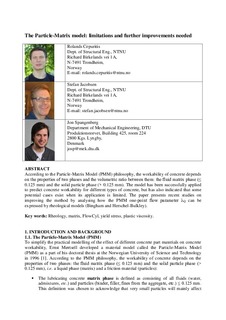| dc.contributor.author | Cepuritis, Rolands | |
| dc.contributor.author | Jacobsen, Stefan | |
| dc.contributor.author | Spangenberg, Jon | |
| dc.date.accessioned | 2018-01-03T11:49:49Z | |
| dc.date.available | 2018-01-03T11:49:49Z | |
| dc.date.created | 2017-09-11T11:56:50Z | |
| dc.date.issued | 2017 | |
| dc.identifier.citation | Nordic Concrete Research. 2017, Proceedings of the XXIII Nordic Concrete Research Symposium, Part 4, 349-352. | nb_NO |
| dc.identifier.issn | 0800-6377 | |
| dc.identifier.uri | http://hdl.handle.net/11250/2474333 | |
| dc.description.abstract | According to the Particle-Matrix Model (PMM) philosophy, the workability of concrete depends on the properties of two phases and the volumetric ratio between them: the fluid matrix phase (≤ 0.125 mm) and the solid particle phase (> 0.125 mm). The model has been successfully applied to predict concrete workability for different types of concrete, but has also indicated that some potential cases exist when its application is limited. The paper presents recent studies on improving the method by analysing how the PMM one-point flow parameter λQ can be expressed by rheological models (Bingham and Herschel-Bulkley). | nb_NO |
| dc.language.iso | eng | nb_NO |
| dc.publisher | Norsk Betongforening | nb_NO |
| dc.title | The Particle-Matrix model: limitations and further improvements needed | nb_NO |
| dc.type | Journal article | nb_NO |
| dc.type | Peer reviewed | nb_NO |
| dc.description.version | acceptedVersion | nb_NO |
| dc.source.pagenumber | 349-352 | nb_NO |
| dc.source.volume | 57 | nb_NO |
| dc.source.journal | Nordic Concrete Research | nb_NO |
| dc.source.issue | 2/17 | nb_NO |
| dc.identifier.cristin | 1492628 | |
| dc.description.localcode | This is the accepted version of the article. | nb_NO |
| cristin.unitcode | 194,64,45,0 | |
| cristin.unitname | Institutt for konstruksjonsteknikk | |
| cristin.ispublished | true | |
| cristin.fulltext | postprint | |
| cristin.qualitycode | 1 | |
